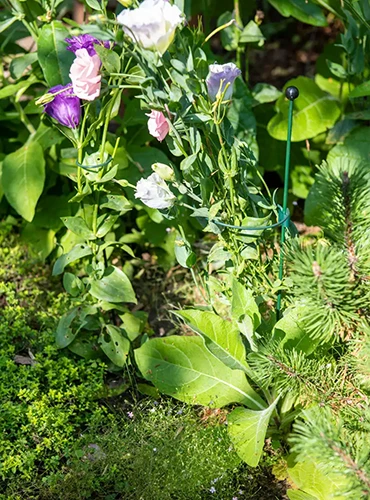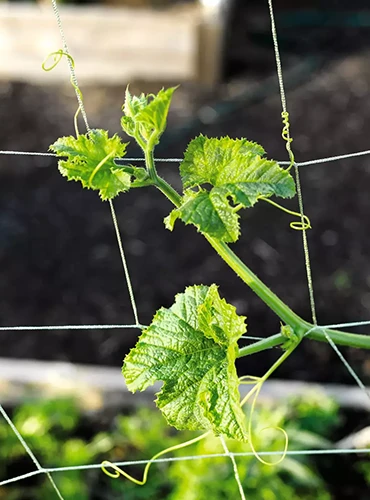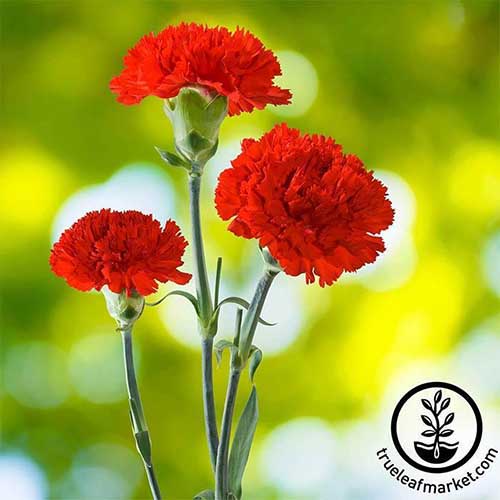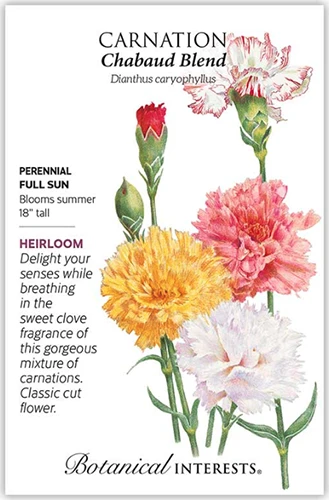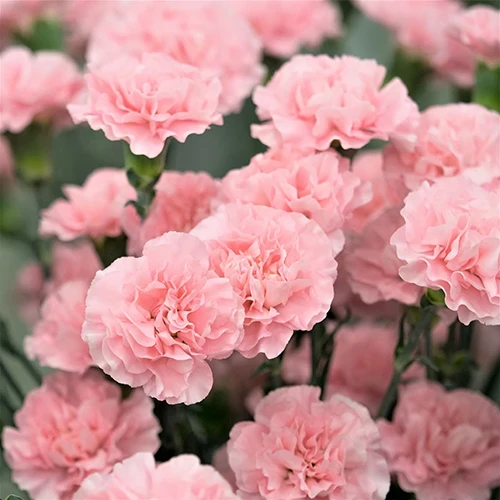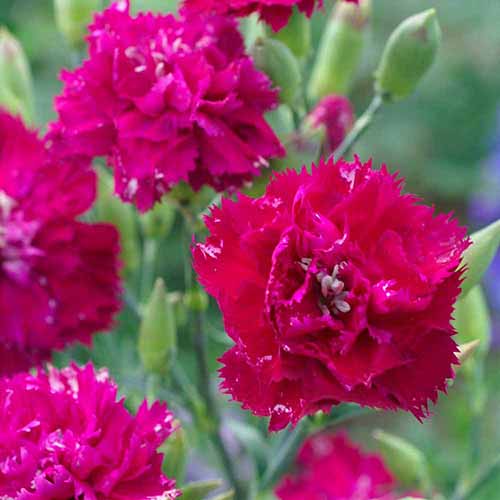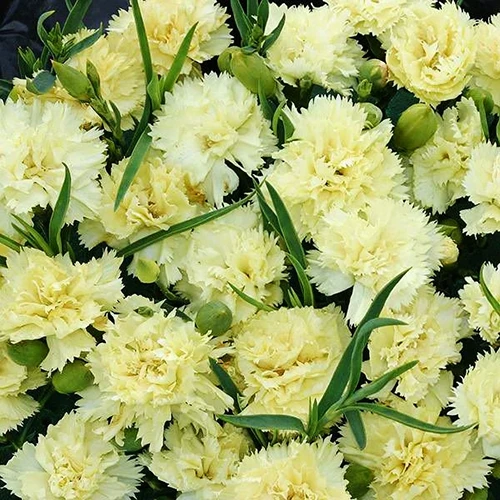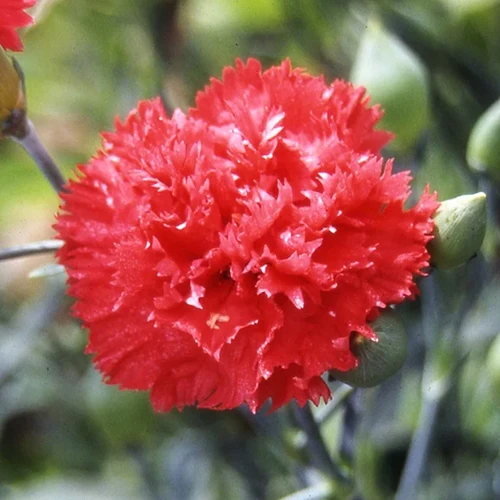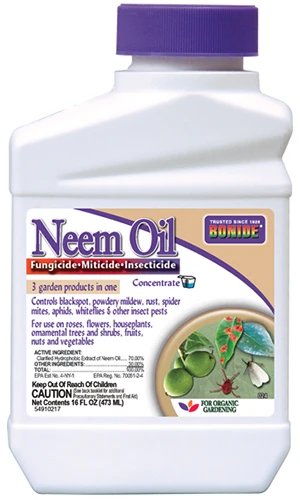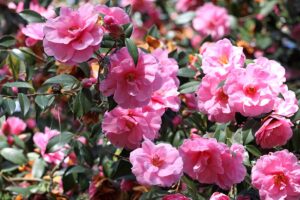Dianthus caryophyllus
Fragrant, frilly, and long-lasting, carnations are easily grown in the garden and among the most popular of cut flowers.
Hardy ornamentals, they make a colorful addition to beds, borders, and containers as well as cottage and rock gardens – and they’re an absolute must-have for cutting gardens.
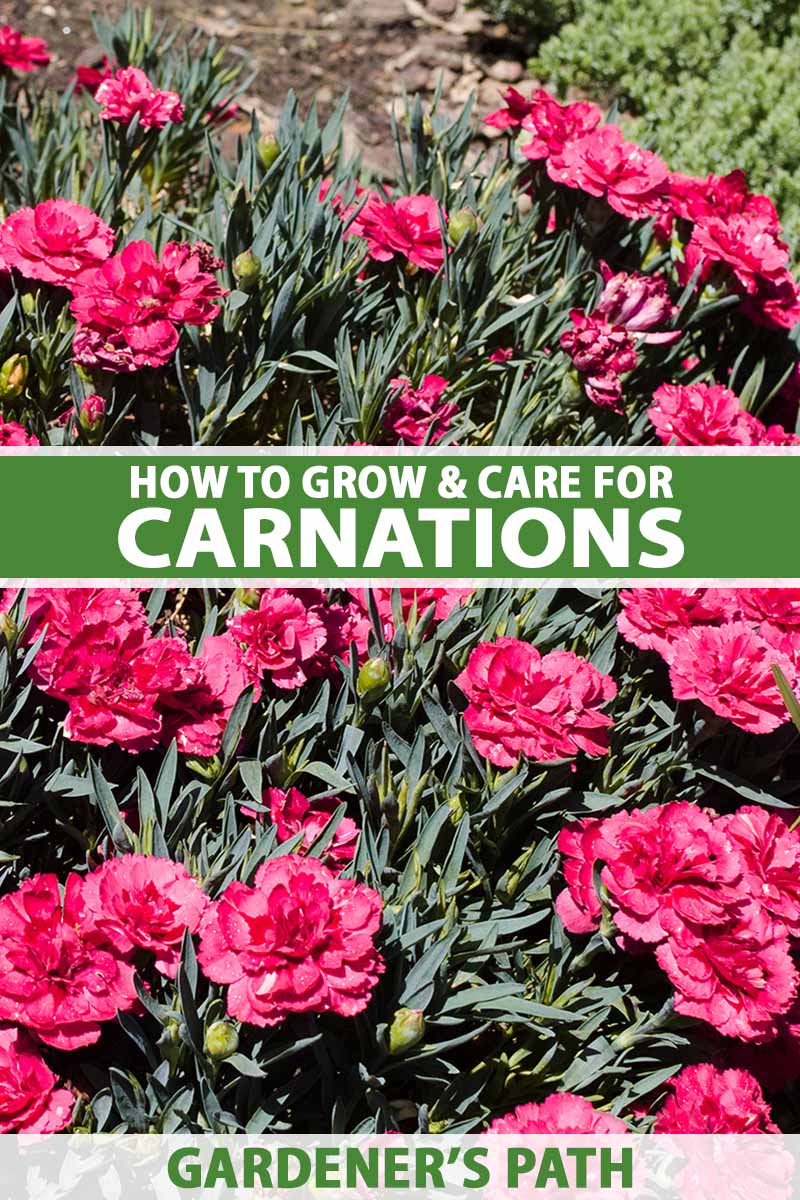
We link to vendors to help you find relevant products. If you buy from one of our links, we may earn a commission.
Blooming profusely from late spring into midsummer, the flowering season is easily extended with regular deadheading.
Many varieties, but not all, feature a delightful, spicy-sweet fragrance from blooms of peach, pink, salmon, scarlet, red, white, yellow, and more recently, purple.
They form attractive, spreading clumps and the narrow, glaucous or blue-green foliage adds beautiful cool tones that remain evergreen or semi-evergreen in mild winter climates.
The flowers are attractive to bees, butterflies, and other pollinators but rabbits, squirrels, and deer leave them alone.
And along with being fabulous cut flowers, they also dry well for inclusion in potpourri mixes or they can be pressed for cardmaking and other artworks.
Are you looking for boldly colorful, fragrant, and easily cultivated perennials? Then join us now for a read on how to grow and care for carnations!
Here’s what’s coming up:
What You’ll Learn
What Are Carnations?
Carnations, Dianthus caryophyllus, are a species of herbaceous perennials sometimes grown as annuals that grow up to 30 inches tall and form attractive, spreading clumps or mats.

The fringed flowers of carnations and their hybrids have a radial symmetry with a sweetly spicy fragrance of cloves.
The scent is lighter than other Dianthus species such as Cheddar pinks (D. gratianopolitanus), and many cultivars are entirely fragrance-free.
The opposing, narrow leaves are a pretty gray-green or blue-green and make a handsome contrasting anchor for the color-saturated flowers floating above.
These edible flowers measure one to two inches across and have a mildly sweet and peppery flavor. Forming on wiry stems, they develop singly or in groups of up to five, with single or double petals.
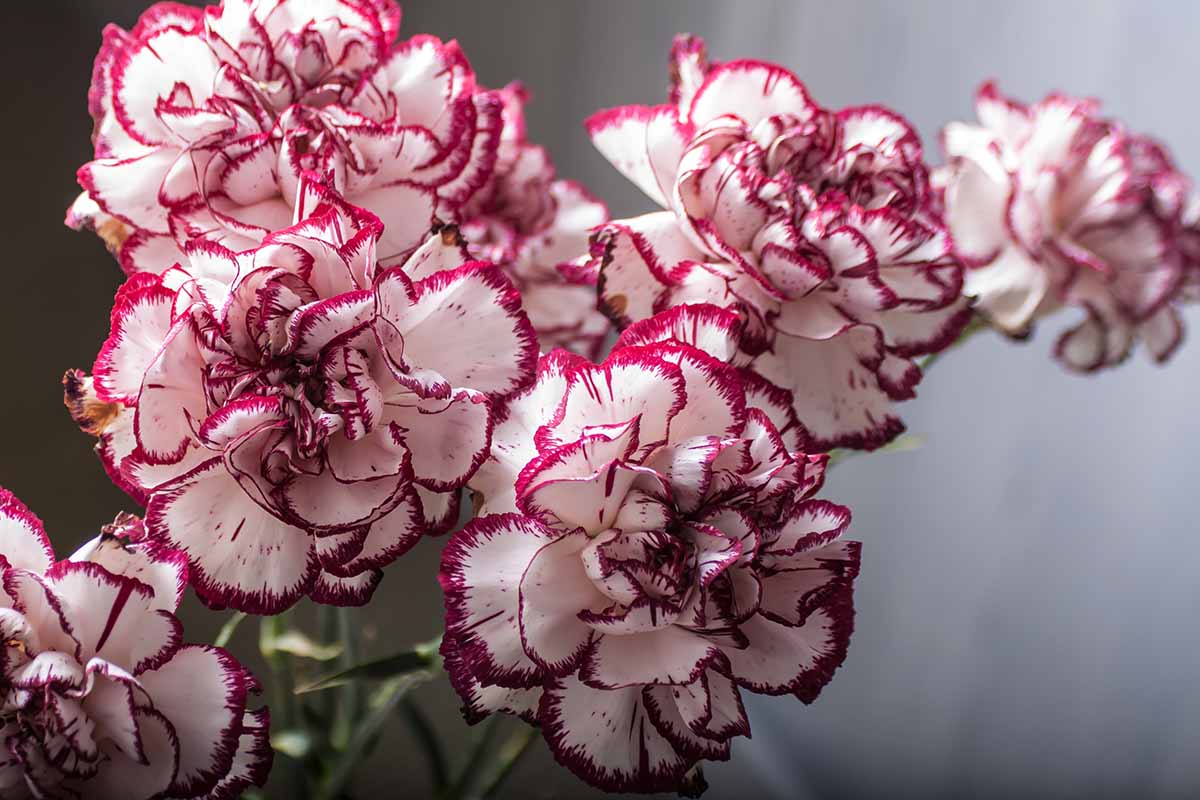
Cultivar colors include vibrant shades of green, peach, pink, salmon, scarlet, purple, red, white, and yellow, with some having striped variations or picotee edging.
Most are hardy in USDA Zones 5 to 9 and flower from mid- to late spring into midsummer.
However, several cultivars give a steady, but lighter, rebloom through late summer when spent flowers are deadheaded.
Cultivation and History
Thought to be natives of the Mediterranean region of southern Europe, cultivation dates back to at least ancient Greek and Roman times.
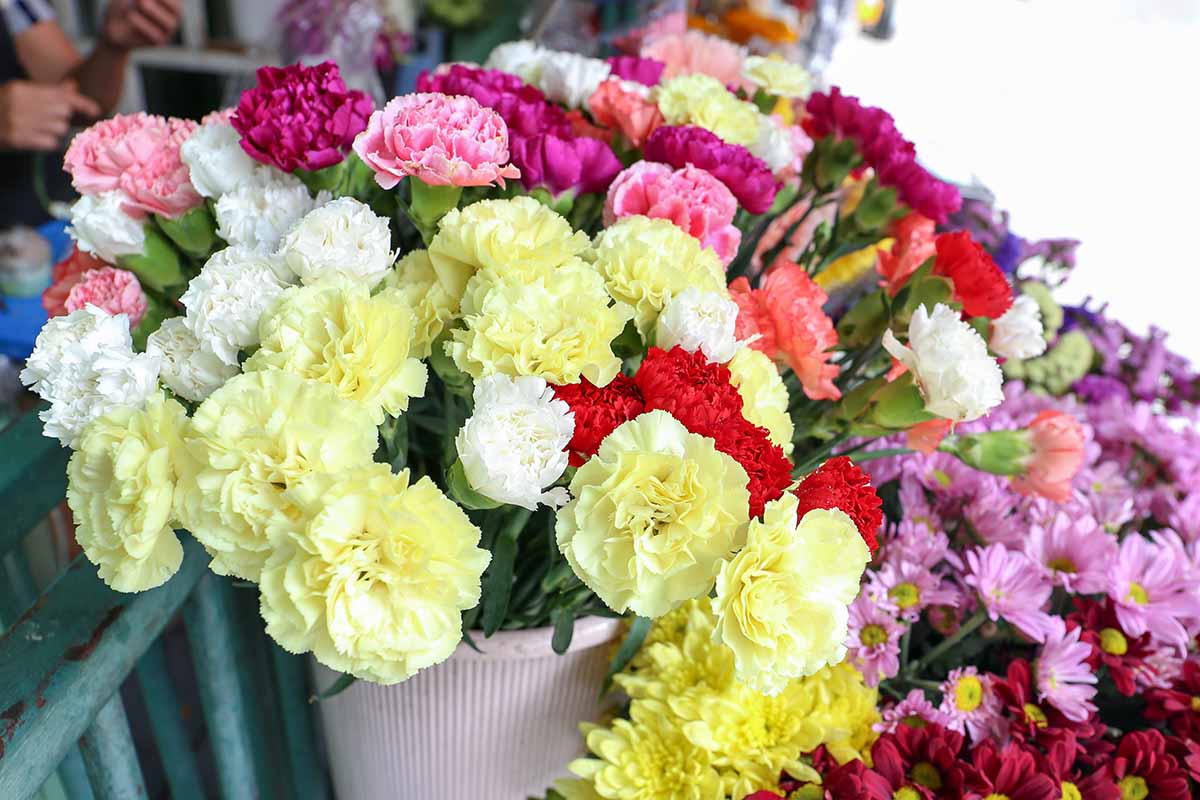
The genus name, Dianthus, is from the Greek words for divine (dios) and flower (anthos), meaning flower of the gods – clearly, they thought they were heaven-scent(ed)!
The species epithet, caryophyllus, refers to the clove scent.
In antiquity, carnations were used in ceremonial crowns, and in some cultures they’re symbolically used to express love and affection, but with variations depending on the flower color.
The three most popular types of carnations are the tall, large-flowered cultivars most often used by florists, and spray or dwarf varieties that are typically grown in the home garden.
Florists’ carnations usually have one to three flowers per stem and typically grow 18 to 30 inches tall. Spray and dwarf varieties have multiple blooms per stem and grow between nine and 24 inches tall.
The Dianthus genus also includes several other popular garden species, such as alpine pinks (D. alpinus), Cheddar pinks (D. gratianopolitanus), China pinks (D. chinensis), garden pinks (D. plumarius), and large pinks (D. superbus).
Propagation
Carnations are propagated by root division, seed, or stem cuttings.
Root Division
Root division is a good way to rejuvenate old plants that are overcrowded or suffering from dieback.
To divide plants, in early autumn dig up the entire clump, inserting your spade a few inches away from the plant’s perimeter to ensure roots aren’t damaged.
Using your fingers or clean, sterile garden shears, pull or cut plants into smaller sections, carefully teasing the roots apart.
Discard the middle or older sections if they’re tired or spent, as well as any pieces with rotting or soft roots. Each section should have several healthy shoots and roots attached.
Plant divisions into prepared locations, ensuring the roots are just below the surface, but keeping the crown and stems above the soil line – avoid burying the crown as this may lead to problems such as crown and root rot.
Stem Cuttings
Professional growers propagate carnations by rooting terminal flower stem cuttings. Terminal flowers are the ones that form at the end of a stem, not where the stem and branch meet.
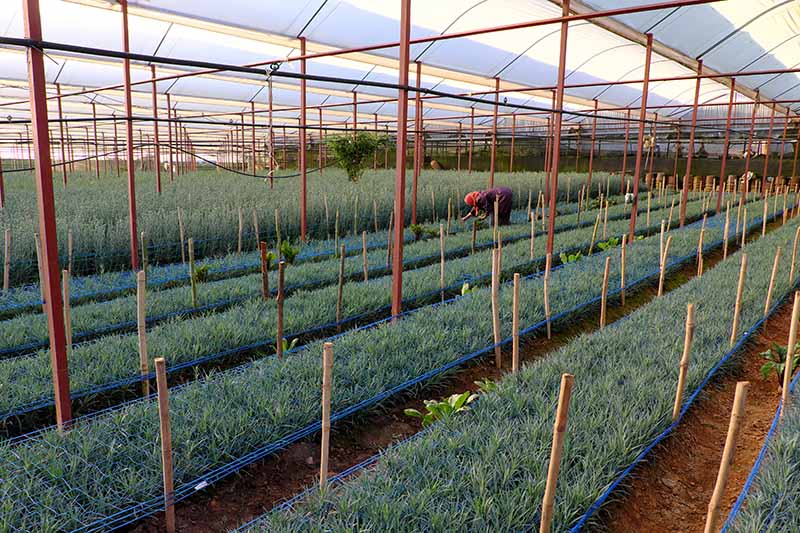
Take four- to six-inch cuttings in summer, preferably in the cool of morning, from non-flowering stems.
Use a clean, sharp knife or scissors to cut just below a set of leaf nodes. Pinch off the bottom set of leaves and dip the cut end into a rooting hormone if desired.
Fill four- to six-inch pots or a seed tray with a fine-textured potting mix and push stems into the soil up to the first set of leaves, spacing evenly so the leaves of different cuttings aren’t touching.
Gently firm the soil around them for stability.
Water gently but thoroughly to saturate the soil then cover with a cloche, dome, or plastic bag.
Place in a bright, sunny windowsill and keep the soil slightly moist until cuttings have rooted, which should happen in about three to four weeks.
Every few days, uncover the cuttings for a couple of hours to allow fresh air circulation, which helps to prevent fungal infections. Once new leaves emerge, take the covers off for good.
When the cuttings are rooted and producing new growth, repot each stem individually and place in a warm, protected site in the garden that’s sheltered from the hot afternoon sun.
As the temperatures drop, you can move them to a cold frame or into a location that’s protected from frost.
Plant out into the garden the following spring.
From Seed
To propagate carnations from seed, they can be started early indoors or sown directly in the ground in April or May – but note that direct-sown seeds are unlikely to flower until their second year.

For first-year flowers, start indoors 12 to 14 weeks prior to your last frost date in spring.
Fill seed trays or small containers with fine-textured and well-draining potting mix.
Sprinkle the seeds evenly across the soil, then cover them lightly.
Water gently until the soil is moist then cover with a cloche, dome, or plastic bag to create a greenhouse effect.
Germination should take place in a few days. After seeds sprout, remove the covers for a couple of hours every few days to allow for air circulation.
Keep the potting medium evenly moist.
Once seedlings have two or three sets of leaves, after all danger of frost has passed, transplant into the garden or into larger containers.
To direct sow outdoors, wait until after all threat of frost has passed.
Prepare beds with fertile, well-draining soil and sow seeds one-eighth of an inch deep.
In the absence of rain, keep them lightly moist but not waterlogged.
Once plants are four to six inches tall, thin to 10 inches apart.
How to Grow
Carnations flower best in fertile, humus-rich soil with a pH of 6.7 to 7.0 in a full sun location – but they do appreciate some shade in areas with very hot afternoon sun.

Prepare and enrich the planting site by amending the soil with compost.
To improve drainage, add granite chips, landscape sand, or pea gravel – Dianthus must have well-draining soil to avoid problems like crown and root rot.
Mix in some bone meal to create strong, healthy roots, using one to two tablespoons per gallon of soil.
Place plants so the crown is just above the soil and then backfill, firming the soil lightly around the roots.
Water gently and thoroughly, and maintain even moisture until established. Once plants are growing well, water them deeply once a week, waiting until the top inch of soil is dry between applications.
Apply mulches carefully and keep moisture-retentive materials away from the crown.
Crowding carnations with thick mulches that hold water can trap too much moisture around the crown and also inhibit air circulation, which can lead to issues like crown rot and fungal infections.
For taller varieties that grow up to 30 inches, a mesh grid netting can be beneficial to protect the wiry stems from wind damage or flopping.
For container growth, Dianthus must have well-draining, humus-rich soil.

Choose planters with drainage holes. I like to add a two-inch layer of drainage material such as broken pottery or pebbles to the pot before filling it with soil – this helps to prevent soggy roots and associated problems.
Enrich the container soil with compost or well-rotted manure and amend with drainage materials like coarse landscape sand or granite chips if needed.
Avoid overcrowding container plants to ensure adequate air circulation and trim the outside stems as needed to prevent overlapping leaves and stems.
Growing Tips
Easy to care for, the following tips will help you to keep your carnations healthy and vibrant:
- Plant in a full sun location and provide afternoon shade in hot regions.
- Ensure proper spacing and water in the morning to prevent fungal infections.
- Tall varieties may need a support to hold stems upright as they grow.
- Divide clumps every three to five years to rejuvenate and revive plants.
Pruning and Maintenance
During the growing season, water plants weekly, giving them a good soak and then allowing the top inch of soil to dry out between applications.
Containers may need to be watered more frequently.

For a long flowering season, cut stems regularly and deadhead by trimming away spent flowers to encourage reblooming.
In early spring, feed bedding plants and containers with a slow-release granular fertilizer or feed with a water-soluble application monthly from early spring to mid-August.
Use an all-purpose formula such as 20-10-20 NPK.
An alternative is to apply a two-inch layer of compost in early spring, raking it gently into the soil around the root zone. Take care to keep compost away from the crown to avoid impeding air circulation.
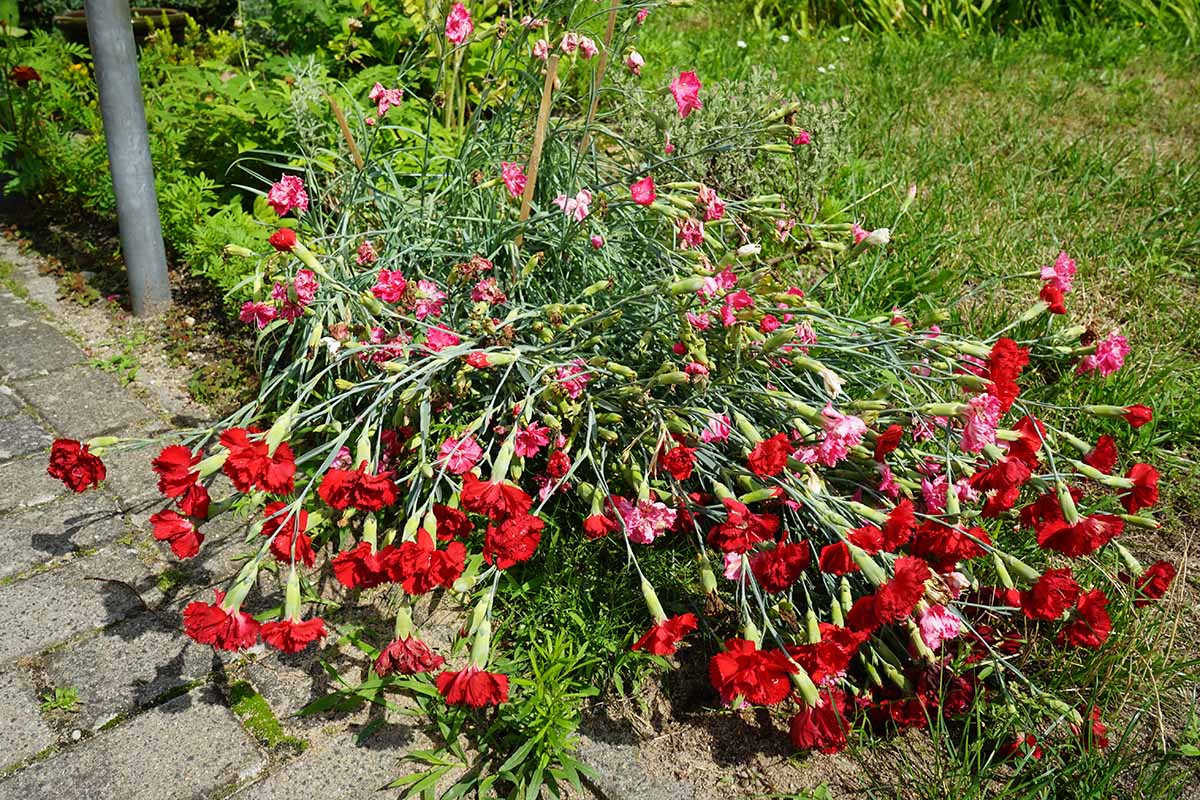
Taller species can benefit from staking should they become top-heavy with flowers. Use any type of stakes such as bamboo, or ones with an adjustable hoop to easily control flopping flowers.
These Peacock mini-stakes with a sliding, eight-inch ring are ideal. They’re available from Gardener’s Supply.
Peacock Mini Plant Support Rings
Another option for staking tall cultivars is to run a 12-inch section of netting between a few anchoring stakes, weaving the net between plants for support.
Place the netting so the top edge is a few inches below the flower buds.
Nylon trellis netting that’s easily cut to size is also available at Gardener’s Supply.
Dianthus species are fairly short-lived and benefit from division every three to five years to rejuvenate plants.
To divide plants, use the same steps that are outlined in the Root Division section above.
To collect seeds, don’t deadhead the last round of flowers and allow the spent flowers to form seed heads.
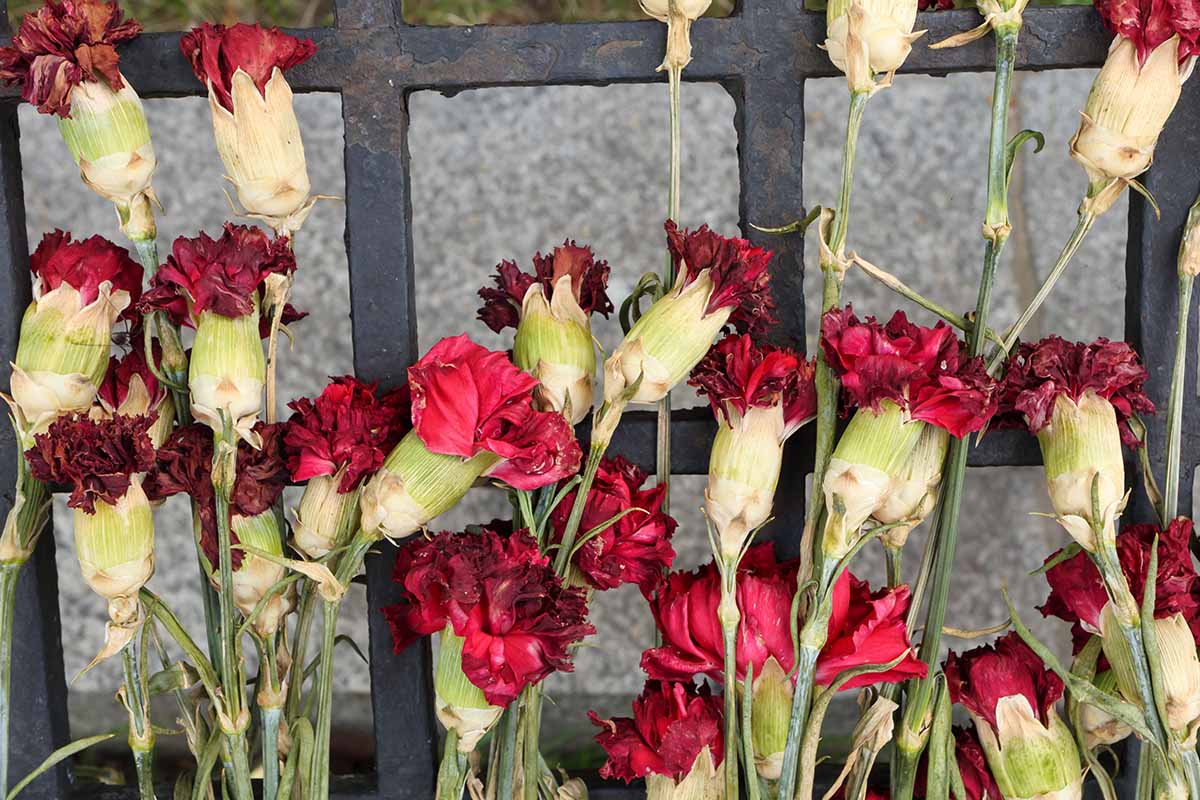
To avoid losing the small seeds, cut the stems before the pods dry out entirely, then finish drying indoors in a warm, dry environment.
You can also invert a small paper bag over the seed heads and secure it in place with twine or an elastic band.
Once the pods are dry, cut the stems and turn bags right side up. Give them a good shake to collect the seeds in the bottom of the bag.
A kitchen sieve is a useful aid for separating seeds from the petal and pod chaff – keep it in your garden tote for small-seeded plants like basil, carnations, and snapdragons.
For full, vibrant clumps with new volunteers each spring, use some of the last round of flowers for self-seeding.
In fall when the seed heads are dry but not fully open, leave them to spread on their own or crush the pods and sprinkle the seeds generously where they grow.
Not all carnation cultivars are self-seeding, but many are. To restrict volunteers, if you’d prefer, be sure to diligently deadhead after flowering.
Remove dead or spent materials and trim plants by up to one-third by mid-autumn. Clean beds of dead or decaying material before winter to deter overwintering of unfriendly pathogens.
To protect plants from winter cold, use only free-draining mulches like pea gravel – heavy, water-retentive materials can lead to issues like crown and root rot. Cover the root zone with two to four inches of gravel but leave the crown clear.
Cultivars to Select
With hundreds of cultivars, the range of carnation choices is extensive. Here are a few popular options to get you started:
CanCan Scarlet
An All-America Selections (AAS) winner for its spicy fragrance, heat tolerance, and long flowering season, the vividly colored ‘CanCan Scarlet’ produces bright red clouds of two-inch, fully double, and highly fragrant blooms.
A vigorous grower with deep, even coloring, the well-branched plants grow 12 to 15 inches on strong, wind-tolerant stems and flower from late spring into fall with regular deadheading.
Hardy in Zones 5 to 10, start seeds indoors 12 to 14 weeks prior to your final frost date for first-year flowers.
Seeds are available at True Leaf Market.
Chabaud Blend
Old-fashioned charmers that are a must for the cutting garden, this Chabaud blend features fragrant flowers in a rainbow mix of colors including pink, purple, scarlet, white, and yellow.
The Chabaud series was developed in France in 1870 and remains among the most popular for the home garden, treasured for their abundant sprays of fringed and ruffled flowers, deep fragrance, and long flowering season.
The edible, spicy-scented blooms flower from late spring into fall with regular deadheading and make excellent cut flowers or a colorful garnish for plates and cold drinks.
Plants grow up to 24 inches tall and are hardy in Zones 6 to 9.
Seed packets are available at Botanical Interests.
La France
A highly perfumed heirloom cultivar with delicately fringed, blush pink flowers, ‘La France’ also has a sweetly spicy scent.
The vigorous plants grow 24 to 30 inches tall and are well-branched, producing a profusion of flowers from late spring into fall if spent blooms are deadheaded.
Hardy in Zones 7 to 9, ‘La France’ is often started indoors early and grown as an annual in other Zones.
Packets and one-ounce packages of seed are available Eden Brothers.
Magenta
A beautiful spray carnation with dense branching and strong stems, ‘Magenta’ is a brilliant shade of raspberry red with a strong, spicy-sweet fragrance.
The dazzling, fully double flowers are ideal for beds, borders, containers, and cutting gardens, and bloom from early summer until frost with regular deadheading.
Plants grow up to 24 inches and are hardy in Zones 6 to 10.
Packets of seed in a variety of sizes are available at Walmart.
Marie Chabaud
A vintage classic with sweetly fragrant, frilly double blooms of pale lemon yellow, ‘Marie Chabaud’ flowers profusely from late spring until late September, an excellent choice for beds, borders, and cut flowers.
Flowers are displayed on sturdy stems in plentiful sprays and grow up to 24 inches.
Plants are hardy in Zones 6 to 8 and can be grown as an annual in colder regions. Regular deadheading prolongs flowering.
Packets and one-ounce packages of seeds are available at Eden Brothers.
Memories
A plant to remember, ‘Memories’ is a highly scented dwarf variety loaded with fully double, pure white blooms that flower from late spring and into fall with regular deadheading.
A beautiful choice for border fronts, containers, edging, and rockeries, the well-branched, petite plants form neat, tidy mounds that grow 10 to 12 inches tall. Hardy in Zones 5 to 9.
Plants can be found at Nature Hills Nursery.
Orange Sherbet
Sweetly satisfying in shades of coral and salmon, ‘Orange Sherbet’ flowers are double petaled and among the most fragrant of spray carnations.
Flowering from early summer through to September with regular deadheading, the densely branched plants grow up to 24 inches tall and are hardy in Zones 6 to 8.
Start seeds indoors and grow ‘Orange Sherbet’ as an annual in colder climates.
Packets and ounces of seeds are available at Eden Brothers.
Managing Pests and Disease
Carnations are increasingly bred for improved disease resistance, but there are still a few issues to watch for.
Aphids, mites, and thrips are common sapsucking pests that can cause streaking, spotting, and yellowing on leaves, petals, and stems.
Often a strong jet of water from the garden hose is enough to take care of these insects, but dense infestations can require the use of a pesticide such as neem oil.
Problems such as bacterial wilt (Burkholderia caryophylli) and fusarium wilt (Fusarium oxysporum) cause problems like drying, stem cracking, yellowing, and wilting, and are fatal to plants.
Remove and destroy infected plants as soon as possible and grow new plants in beds of fresh, pasteurized soil. Also, avoid overhead watering, which spreads bacterial growth through splashing.
Fungal problems such as botrytis blight (Botrytis cinerea) and rust (Uromyces dianthi) can be avoided by ensuring good air circulation, and avoiding overhead watering or watering late in the day.
Remove and destroy infected materials, ensure your tools are sterile when cutting flowers, and spray symptomatic plants with a natural fungicide like neem oil.
You can find Bonide neem oil concentrate in pint, quart, and gallon sizes at Arbico Organics.
Be sure to dilute it with water according to package instructions before use.
Best Uses
With their bewitching fragrance, bright colors, and long flowering season, carnations add vivid charm to a number of settings.
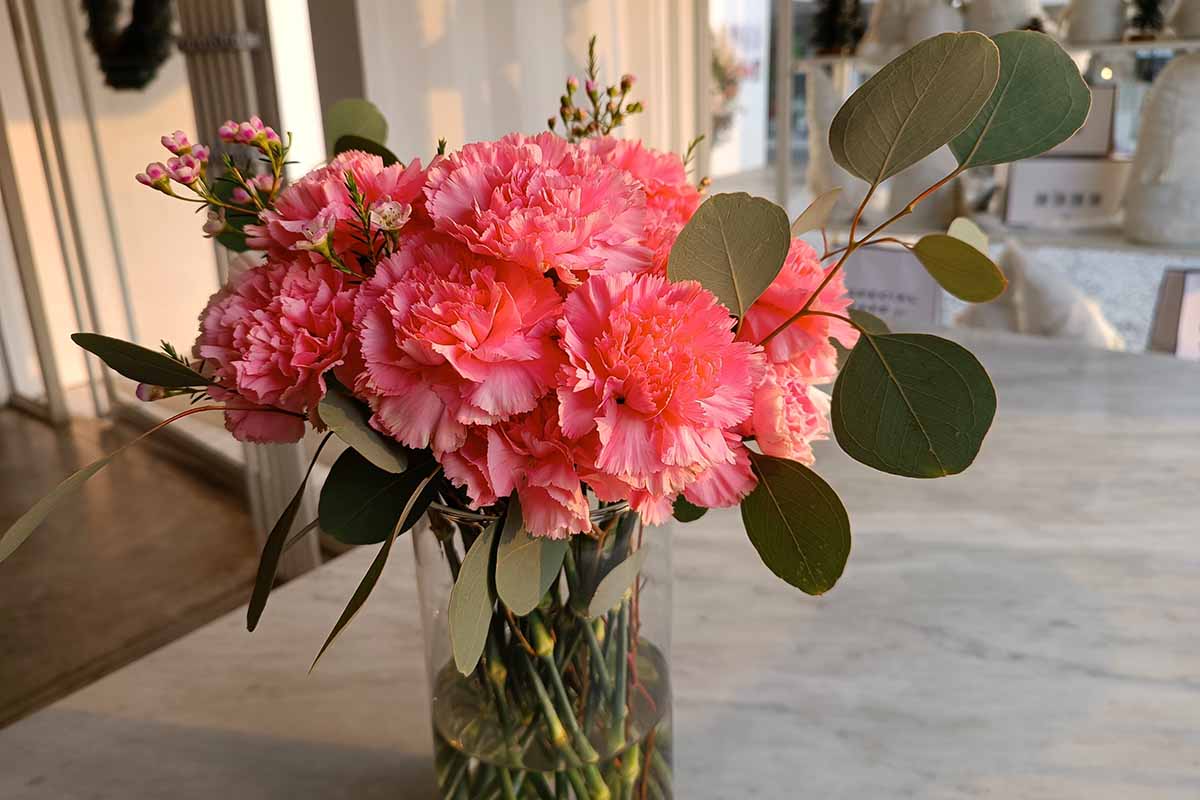
For long-lasting, juicy pops of color, add them to beds, borders, islands, rockeries, and containers.
To enjoy their fragrance, they’re a natural for edging paths and patios, planters around seating areas, and window boxes as well.
They’re a mainstay in butterfly and cottage gardens as well as wildflower meadow blends.
And don’t forget the cutting garden… you’ll want to plant plenty to bring these long-lasting and fragrant (or not if you prefer!) beauties indoors for floral arrangements.
They’re also a sensation when dried and added to potpourri blends or pressed for cards, papermaking, posters, and more.
Quick Reference Growing Guide
| Plant Type: | Perennial flower | Flower / Foliage Color: | Glaucous, blue-green/pink, peach, salmon, scarlet, purple, red, white, yellow |
| Native to: | Mediterranean region | Tolerance: | Deer, rabbits, rodents |
| Hardiness (USDA Zone): | 5-10, depending on cultivar | Maintenance: | Low |
| Season: | Late spring-summer | Soil Type: | Organically rich, fertile |
| Exposure: | Full sun | Soil pH: | 6.7-7.0 |
| Spacing: | 6-12 inches | Soil Drainage: | Well-draining |
| Planting Depth: | 1/8-inch (seeds), depth of container (transplants) | Attracts: | Bees, butterflies, other pollinators |
| Height: | 9-30 inches | Uses: | Beds, borders, containers, edging; butterfly, cottage, cutting, and rock gardens |
| Spread: | 8-14 inches | Family: | Caryophyllaceae |
| Water Needs: | Moderate | Genus: | Dianthus |
| Common Pests and Diseases: | Aphids, mites, thrips; bacterial wilt, fusarium wilt, botrytis blight, rust | Species: | Caryophyllus |
Showy and Perfumed
With their vivid, highly saturated colors and sweet fragrance, carnations are a welcome addition throughout the garden.
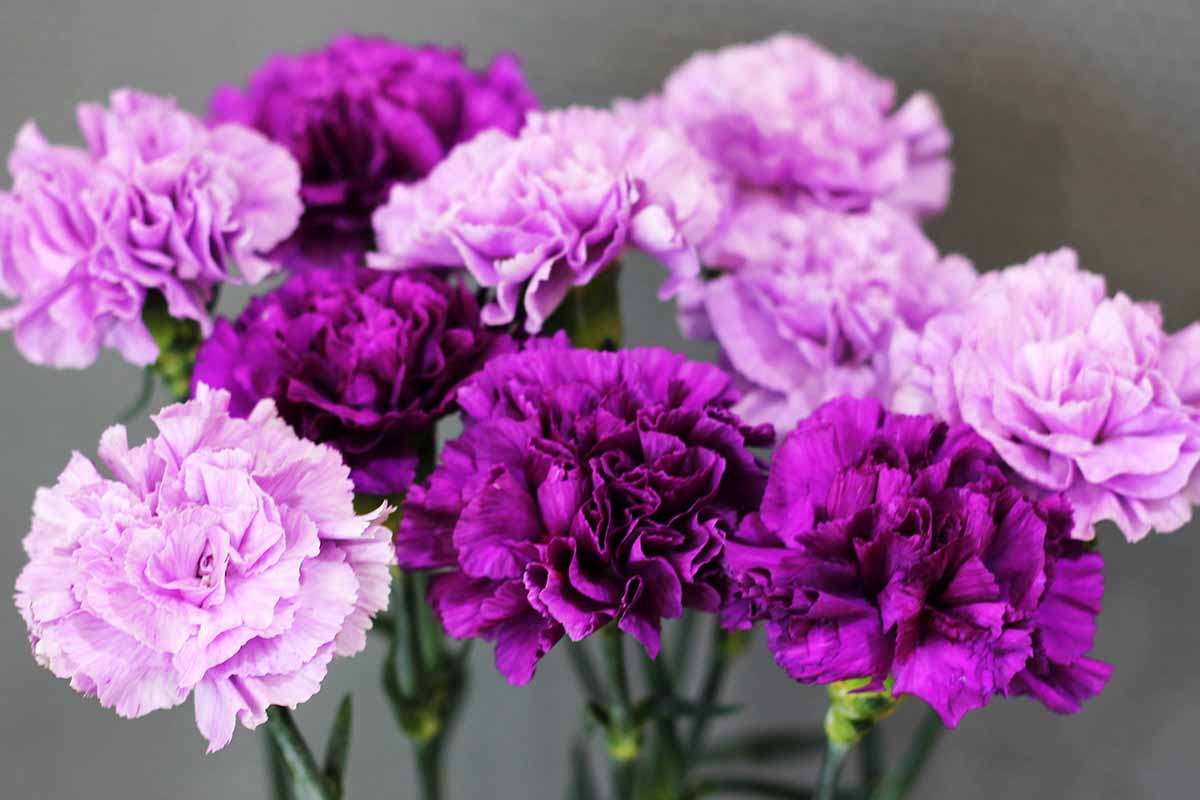
Their easy care and long flowering time is ideal for plantings where their perfume can be enjoyed, like edging beds and pathways or in containers, patio planters, and window boxes.
Plus, they’re an excellent, pollinator-attracting addition to butterfly, cottage, and rock gardens.
However you use them, be sure to plant plenty for cutting so you can bring their showy, perfumed beauty indoors as well!
How do you use carnations in the garden? Tell us about it in the comments section below.
And for more Dianthus know-how, be sure to add these guides to your reading list next:
